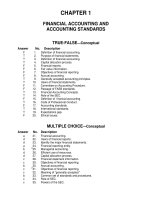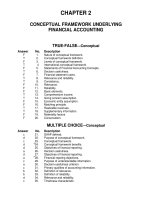Test bank cost and management accounting 4e by barfield ch13
Bạn đang xem bản rút gọn của tài liệu. Xem và tải ngay bản đầy đủ của tài liệu tại đây (61.71 KB, 43 trang )
��#ࡱ#�################>###��
#################�###########�#######����####�###�###���������������������������
��������������������������������������������������������������������������������
��������������������������������������������������������������������������������
��������������������������������������������������������������������������������
��������������������������������������������������������������������������������
��������������������������������������������������������������������������������
���#Y#
#####�###############%�####bjbj�W�W##################
###2###�=##�=##��######s#######################��##########��##########��#######
###########]#####R#######R###R#######R#######R#######R#######R###############f##
#####f#######f#######f###8###�###4###�###l###f###########�###�#######�###:###�##
#####�#######�#######�#######�#######�#######�
######�
######�
######�
##N###3
##L###ࡱ###L###�###$###�###�###�###�###�#######################R#######�#########
##############�#######�#######�#######�#######�#######�#######R#######R#######�#
##############�###�###�#######�#######�#######�#######�###�###R#######�#######R#
######�#######�
######################f#######f#######R#######R#######R#######R#######�#######�
######�###`###�###############�
######R#######R###############################################################�
######�#######>###t###�o�L~��#f#######f#######U###.###�
################################################################################
############################################################CHAPTER 13THE MASTER
BUDGETMULTIPLE CHOICE1. A budget aids in a.
communication.
b.
motivation. c.
coordination.
d.
all of the above. ANSWER:
d
EASY2.
Measuring the firm�s performance against established
objectives is part of which of the following functions?
a.
Planning
b.
Controlling c.
Organizing d.
Staffing
ANSWER:
b
EASY3.
The preparation of an organization�s budget
a.
forces
management to look ahead and try to see the future of the organization.
b.
requires that the entire management team work together to make and carry
out the yearly plan.
c.
makes performance review possible at all levels of
management. d.
all of the above. ANSWER:
d
EASY4.
Which of the
following is a basic element of effective budgetary control?
a.
cost
behavior patterns b.
cost-volume-profit analysis
c.
standard costing d.
all of the above ANSWER:
a
EASY
5.
When actual performance varies from the budgeted performance, managers
will be more likely to revise future budgets if the variances were
a.
controllable rather than uncontrollable. b.
uncontrollable rather than
controllable.
c.
favorable rather than unfavorable. d.
small.
ANSWER:
b
MEDIUM6.
External factors that cause the achievement
of company goals are the
a.
annual budget.
b.
industry price and
cost structure.
c.
talents possessed by its managers. d.
board of
directors.
ANSWER:
b
EASY7.
A budget is a.
a planning
tool. b.
a control tool.
c.
a means of communicating goals to the firm�s
divisions. d.
all of the above.
ANSWER:
d
EASY8.
Ineffective budgets and/or control systems are characterized by the use of
a.
budgets as a planning tool only and disregarding them for control
purposes.
b.
budgets for motivation. c.
budgets for coordination.
d.
the budget for communication.
ANSWER:
a
EASY9.
Strategic
planning is a.
planning activities for promoting products for the future. b.
planning for appropriate assignments of resources.
c.
setting
standards for the use of important but hard-to-find materials.
d.
stating
and establishing long-term plans. ANSWER:
d
EASY
10.
Key variables that are identified in strategic planning area.
normally
controllable if they are internal. b.
seldom if ever controllable. c.
normally controllable if they occur in a domestic market. d.
normally
uncontrollable if they are internal.
ANSWER:
a
EASY11.
Tactical
planning usually involves which level of management? a.
middle
b.
top
c.
middle and top
d.
operational ANSWER:
c
EASY12.
Which of the following statements is true?
a.
All organizations
have the same set of budgets. b.
All organizations are required to budget. c.
Budgets are a quantitative expression of an organization�s goals and
objectives. d.
Budgets should never be used to evaluate performance.ANSWER:
c
EASY13.
Which of the following is not an �operating� budget? a.
sales budget
b.
production budget c.
purchases budget d.
capital budget
ANSWER:
d
EASY14.
The master budget is a
static budget because it
a.
is geared to only one level of production
and sales. b.
never changes from one year to the next. c.
covers a preset
period of time.
d.
always contains the same operating and financial
budgets.
ANSWER:
a
EASY
15.
The master budget is a a.
static budget.
b.
flexible budget. c.
qualitative expression of a prior goal. d.
qualitative expression of a
future goal.
ANSWER:
a
EASY16.
The master budget usually
includes
a.
an operating budget.
b.
a capital budget.
c.
pro
forma financial statements.
d.
all of the above. ANSWER:
d
EASY17.
Which of the following is usually perceived as being the master budget�s
greatest advantage to management? a.
performance analysis
b.
increased
communication
c.
increased coordination d.
required planning ANSWER:
d
EASY18.
Chronologically, the first part of the master budget to
be prepared would be the
a.
sales budget.
b.
production budget.
c.
cash budget.
d.
pro forma financial statements.
ANSWER:
a
EASY19.
An example of a recurring short-term plan is
a.
a
probable product line change. b.
expansion of plant and facilities. c.
a
unit sales forecast.
d.
a change in marketing strategies. ANSWER:
c
EASY
20.
If the chief accountant of a firm has to prepare an operating budget for
the coming year, the first budget to be prepared is the
a.
sales budget.
b.
cash budget.
c.
purchases budget. d.
capital budget.
ANSWER:
a
EASY21.
It is least likely that a production budget
revision would cause a revision in the
a.
capital budget.
b.
cash
budget.
c.
purchases budget. d.
pro forma balance sheet.
ANSWER:
a
EASY22.
Budgeted production for a period is equal to
a.
the
beginning inventory + sales � the ending inventory. b.
the ending inventory
+ sales � the beginning inventory. c.
the ending inventory + the beginning
inventory � sales.
d.
sales � the beginning inventory + purchases.
ANSWER:
b
EASY23.
Chronologically, in what order are the
sales, purchases, and production budgets prepared?
a.
sales, purchases,
production b.
sales, production, purchases c.
production, sales,
purchases
d.
purchases, sales, production ANSWER:
b
EASY
24.
The material purchases budget tells a manager all of the following except
the
a.
quantity of material to be purchased each period.
b.
quantity
of material to be consumed each period. c.
cost of material to be purchased
each period.
d.
cash payment for material each period.
ANSWER:
d
EASY25.
Of the following budgets, which one is least likely to be
determined by the dictates of top management? a.
sales b.
material usage
c.
revenues
d.
general and administrative
ANSWER:
b
EASY26.
The amount of raw material purchased in a period may be
different than the amount of material used that period because
a.
the
number of units sold may be different from the number of units produced.
b.
finished goods inventory may fluctuate during the period. c.
the raw
material inventory may increase/decrease during the period.d.
companies often
pay for material in the period after it is purchased. ANSWER:
c
MEDIUM27.
A purchases budget is
a.
not affected by the firm�s policy of
granting credit to customers. b.
the same thing as a production budget.
c.
needed only if a firm does not pay for its merchandise in the same period
as it is purchased.
d.
affected by a firm�s inventory policy only if the
firm purchases on credit.
ANSWER:
a
EASY
28.
Which of the following equations can be used to budget purchases?
(BI
= beginning inventory, EI = ending inventory desired, CGS = budgeted cost of
goods sold, P = budgeted purchases) a.
P = CGS + BI � EI b.
P = CGS + BI
c.
P = CGS + EI + BI d.
P = CGS + EI � BI ANSWER:
d
EASY29.
Both the budgeted quantity of material to be purchased and the budgeted
quantity of material to be consumed can be found in the
a.
material
purchases budget. b.
production budget.
c.
pro forma income statement.
d.
cash budget.
ANSWER:
a
EASY30.
A company that
maintains a raw material inventory, which is based on the following month�s
production needs, will purchase less material than it uses in a month where a.
sales exceed production.
b.
production exceeds sales.
c.
planned production exceeds the next month�s planned production. d.
planned production is less than the next month�s planned production.
ANSWER:
c
MEDIUM31.
If a company has a policy of maintaining an
inventory of finished goods at a specified percentage of the next month�s
budgeted sales, budgeted production for January will exceed budgeted sales for
January when budgeted
a.
February sales exceed budgeted January sales. b.
January sales exceed budgeted December sales. c.
January sales exceed
budgeted February sales.
d.
December sales exceed budgeted January
sales.
ANSWER:
a
MEDIUM
32.
Depreciation on the production equipment would appear in which of the
following budgets?
a.
cash budget b.
production budget c.
selling
and administrative expense budget d.
manufacturing overhead budget ANSWER:
d
EASY33.
The selling, general, and administrative expense budget
is based on the _______________ budget. a.
production b.
sales c.
cash d.
purchases
ANSWER:
b
EASY34.
The budgeted amount
of selling and administrative expense for a period can be found in the a.
sales budget.
b.
cash budget.
c.
pro forma income statement.
d.
pro forma balance sheet.
ANSWER:
c
EASY35.
Which of
the following represents a proper sequencing in which the budgets below are
prepared?
a.
Direct Material Purchases, Cash, Sales
b.
Production,
Sales, Income Statement c.
Sales, Balance Sheet, Direct Labor d.
Sales,
Production, Manufacturing Overhead
ANSWER:
d
EASY
36.
The detailed plan for the acquisition and replacement of major portions of
property, plant, and equipment is known as the a.
capital budget.
b.
purchases budget. c.
commitments budget.
d.
treasury budget.
ANSWER:
a
EASY37.
The budgeted payment for labor cost each
period would be found in the a.
labor budget.
b.
pro forma income
statement. c.
selling, general, and administrative expense budget. d.
cash budget.
ANSWER:
d
EASY38.
The cash budget ignores all
a.
dividend payments.
b.
sales of capital assets.
c.
noncash accounting accruals. d.
sales of common stock. ANSWER:
c
EASY39.
Which of the following items would not be found in the
financing section of the cash budget?
a.
cash payments for debt retirement
b.
cash payments for interest
c.
dividend payments d.
payment
of accounts payable
ANSWER:
d
EASY
40.
The primary reason that managers impose a minimum cash balance in the cash
budget is
a.
because management needs discretionary cash for unforeseen
business opportunities. b.
managers lack discipline to control their
spending.
c.
that it protects the organization from the uncertainty of the
budgeting process.
d.
that it makes the financial statements look more
appealing to creditors. ANSWER:
c
EASY41.
Chronologically, the last
part of the master budget to be prepared would be the a.
pro forma financial
statements. b.
cash budget.
c.
capital budget
d.
production
budget.
ANSWER:
a
EASY42.
The pro forma income statement is not
a component of the
a.
master budget.
b.
financial budgets.
c.
operating budgets.
d.
capital budget.
ANSWER:
c
EASY43.
A pro forma financial statement is a.
a financial statement for past
periods.
b.
a projected or budgeted financial statement.
c.
presented
for the form but contains no dollar amounts.
d.
a statement of planned
production.
ANSWER:
b
EASY
44.
A master budget contains which of the following?
Sales
Production Pro forma statements
a.
yes
yes
yes
b.
no
no
yes
c.
no
no
no
d.
yes
no
yes
ANSWER:
a
EASY45.
The budgeted cost of products to be sold in a future period would be found
in the
a.
production budget.
b.
sales budget.
c.
purchases
budget.
d.
pro forma income statement.
ANSWER:
d
EASY46.
A
budget that includes a 12-month planning period at all times is called a
____________ budget.
a.
pro forma
b.
flexible
c.
master
d.
continuous ANSWER:
d
EASY47.
The method of budgeting that adds
one month�s budget to the end of the plan when the current month�s budget is
dropped from the plan is called ____________ budgeting.
a.
long-term
b.
operations c.
incremental
d.
continuous ANSWER:
d
EASY
48.
Slack in operating budgets
a.
results from unintentional managerial
acts. b.
makes an organization more efficient and effective. c.
requires
managers to work harder to achieve the budget. d.
is greater when managers
are allowed to participate in the budgeting process. ANSWER:
d
EASY49.
Budget slack is a condition in which
a.
demand is low at various
times of the year.
b.
excess machine capacity exists in some areas of
the plant. c.
there is an intentional overestimate of expenses or an
underestimate of revenues.
d.
managers grant favored employees extra time
off. ANSWER:
c
EASY50.
E Co. has the following expected pattern of
collections on credit sales: 70 percent collected in the month of sale, 15
percent in the month after the month of sale, and 14 percent in the second month
after the month of sale. The remaining 1 percent is never collected. At the end
of May, E Co. has the following accounts receivable balances:
From
April sales $21,000
From May sales
48,000
E�s expected sales
for June are $150,000. What were total sales for April?
a.
$150,000
b.
$72,414
c.
$70,000
d.
$140,000
ANSWER:
d
MEDIUM
51.
Ball Company has a policy of maintaining an inventory of finished goods
equal to 30 percent of the following month�s sales. For the forthcoming month of
March, Ball has budgeted the beginning inventory at 30,000 units and the ending
inventory at 33,000 units. This suggests that a.
February sales are budgeted
at 10,000 units less than March sales.
b.
March sales are budgeted at
10,000 units less than April sales. c.
February sales are budgeted at 3,000
units less than March sales. d.
March sales are budgeted at 3,000 units less
than April sales. ANSWER:
b
MEDIUM52.
Budgeted sales for the first six
months of 2001 for Henry Corp. are listed below:
JANUARY
FEBRUARY
MARCH APRIL MAY
JUNE UNITS:
6,000 7,000 8,000 7,000 5,000 4,000
Henry Corp. has a policy of maintaining an inventory of finished goods equal to
40 percent of the next month�s budgeted sales. If Henry Corp. plans to produce
6,000 units in June, what are budgeted sales for July?
a.
3,600 units b.
1,000 units c.
9,000 units d.
8,000 units ANSWER:
c
DIFFICULT
53.
McGill Co. manufactures card tables. The company has a policy of
maintaining a finished goods inventory equal to 40 percent of the next month�s
planned sales. Each card table requires 3 hours of labor. The budgeted labor
rate for the coming year is $13 per hour. Planned sales for the months of April,
May, and June are respectively 4,000; 5,000; and 3,000 units. The budgeted
direct labor cost for June for McGill Co. is $136,500. What are budgeted sales
for July for McGill Co.?
a.
3,500 units b.
4,250 units c.
4,000
units d.
3,750 units ANSWER:
b
DIFFICULT
54.
Budgeted sales for K Inc. for the first quarter of 2001 are shown below:
JANUARY
FEBRUARY
MARCH UNITS:
35,000
25,000
32,000The company has a policy that requires the ending inventory in each
period to be 10 percent of the following period�s sales. Assuming that the
company follows this policy, what quantity of production should be scheduled for
February?
a.
24,300 units
b.
24,700 units
c.
25,000 units
d.
25,700 units
ANSWER:
d
MEDIUM55.
Budgeted sales for
the first six months of 2001 for Henry Corp. are listed below:
JANUARY
FEBRUARY
MARCH APRIL MAY
JUNE UNITS:
6,000 7,000 8,000 7,000
5,000 4,000Henry Corp. has a policy of maintaining an inventory of
finished goods equal to 40 percent of the next month�s budgeted sales. How many
units has Henry Corp. budgeted to produce in the first quarter of 2001?
a.
21,400 units
b.
20,600 units
c.
19,000 units
d.
23,000 units
ANSWER:
a
DIFFICULT
56.
Production of Product X has been budgeted at 200,000 units for May. One
unit of X requires 2 lbs. of raw material. The projected beginning and ending
materials inventory for May are:
Beginning inventory: 2,000 lbs.
Ending
inventory: 10,000 lbs. How many lbs. of material should be purchased during
May? a.
192,000
b.
208,000
c.
408,000
d.
416,000
ANSWER:
c
MEDIUM57.
X Co. manufactures toy airplanes.
Information on X Co.�s labor costs follow:
Sales commissions $5 per plane
Administration
$10,000 per month
Indirect factory labor $3 per
plane
Direct factory labor
$5 per plane
The following information
applies to the upcoming month of July for X Co.:
Budgeted production
1,200 units
Budget sales
1,000 units What amount of budgeted
labor cost would appear in the July selling, general, and administrative expense
budget?
a.
$10,000
b.
$16,000
c.
$15,000
d.
$23,000
ANSWER:
c
MEDIUM
58.
McGill Co. manufactures card tables. The company has a policy of
maintaining a finished goods inventory equal to 40 percent of the next month�s
planned sales. Each card table requires 3 hours of labor. The budgeted labor
rate for the coming year is $13 per hour. Planned sales for the months of April,
May, and June are respectively 4,000; 5,000; and 3,000 units. What is McGill
Co.�s budgeted direct labor cost for May? a.
$54,600
b.
$163,800
c.
$226,200
d.
$179,400
ANSWER:
b
DIFFICULT59.
X Co.
manufactures toy airplanes. Information on X Co.�s labor costs follow:
Sales commissions $5 per plane
Administration
$10,000 per month
Indirect factory labor $3 per plane
Direct factory labor
$5 per
plane The following information applies to the upcoming month of July for X Co.:
Budgeted production
1,200 units
Budget sales
1,000 units
What is X Co.�s budgeted factory labor cost for July? a.
$8,000
b.
$15,600
c.
$25,600
d.
$9,600
ANSWER:
d
MEDIUM









